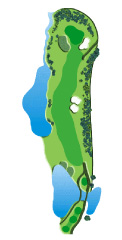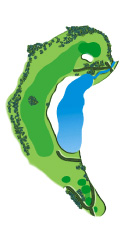ホール番号をクリックすると、
各ホールの詳細をご覧いただけます。
| 合計 | F・B | B・T | R・T | L・T | PAR |
|---|---|---|---|---|---|
| 7149 | 6681 | 6258 | 5306 | 72 |
| COURSE RATE | F・B | B・T | R・T | G・T | L・T |
|---|---|---|---|---|---|
| 73.8 | 71.6 | 69.8 | 68.1 | 71.0 |
コース設計のポイント
Course Design
Spacious 18 holes
18 holes were created with a spacious course width and space between courses in a space that could accommodate 36 holes.
Shot value-oriented design
If you choose the correct strategy route and make a nice shot, you can easily aim for the green on your next shot, and you can easily get a par chance. On the other hand, it is a course that emphasizes shot value, as severe situations await if you take the wrong route or miss a shot. Therefore, it can be said that it is a course with few lucky chances.
All hazards can be seen
Hazards (obstacles) such as grass bunkers, sand bunkers, ponds, creeks, etc. are set to be visible from the tee ground and IP (intermediate point). There are no hidden hazards and all greens can be seen from the IP. Another feature of this course is that it uses a lot of grass bunkers, and the sand bunkers use fine white sand from Fuzhou, China, which gives the bunker shots a special touch.
Wide fairway and course without OB pile
It has sufficient distance and wide fairway. Also, the rough has enough space. The turf area is about 700,000 m2, which is about twice as large as the general course. The distance between the adjacent holes is sufficient, and the playing zone is wide and there are no OB zones (areas where play is prohibited), so it is the original appearance of the golf course.
Course height difference is only 20m, however there are some moderate changes in the flat.
Centering on flat holes, which are one of the most important conditions of prestigious courses, all holes have appropriate undulations and elevation differences to stimulate strategic interest. In particular, the finishing hole is a downhill long hole with a difference in height toward the clubhouse, so it is possible to hit the ball in two. The height difference between the tee and the green
・・・H9/10.5m, H18/12.5m
Four tee grounds with different landscapes produce a variety of attack routes
The four tee grounds avoid simple layouts and are skillfully intertwined with hazards such as ponds, giving a great change in difficulty and scenery. The psychological effect on the player is also a calculated strategic tee ground.
Ideal routing
The holes are oriented 360 degrees north, south, east and west, and the number of straight, left and right curved holes is well balanced for ideal routing. The final 3 holes take advantage of the unique combination of par 3.4.5 on both the front nine and the back nine. The hole angles are straight 7, right curve 3, left curve 4 and short 4.
A more beautiful and more strategic scenic pond
Lake Shinji (20,000㎡), Lake Toen (16,000㎡), Bikuni Pond (5,000㎡), Asakagami Pond (5,000㎡), Lake Shunbo (7,000㎡), Lake Narukin (12,000㎡), Lake Soshu (46,000㎡) ) and Unmuzawa (29,000 m2)…The water surface of the scenic pond, which covers a total of 140,000 m2, is slightly lower than the ground, making the water’s edge stand out.
Strategic bent one green
The green is the one green that it should be, and uses the highest grade Penn Cross bent turf, which is said to have the highest putting quality. The floor soil structure adopts the USGA (United States Golf Association) method. For the green sand, we use sand from Lake Mutsu Ogawara in Aomori Prefecture, which has excellent grain shape, particle size distribution, and water permeability. The green is a pattern strategy green with a different face and 3-4 small stages for each hole. Players can enjoy creative putting with different tastes and undulations on each playing day in a cup where the stage can be changed every day.




















